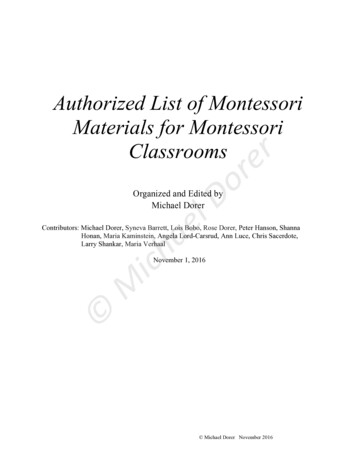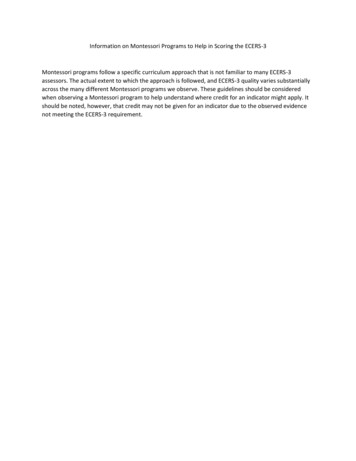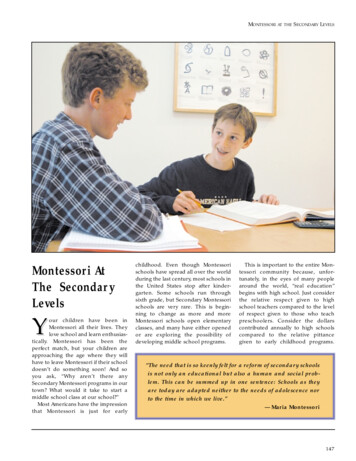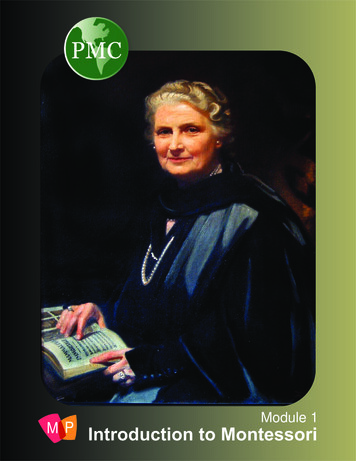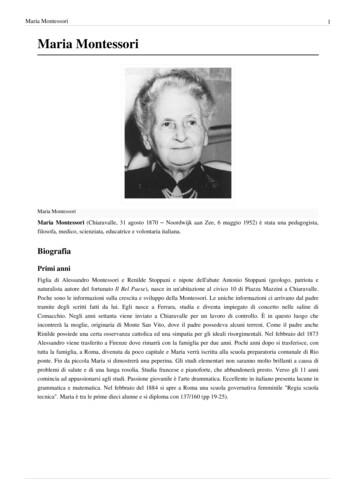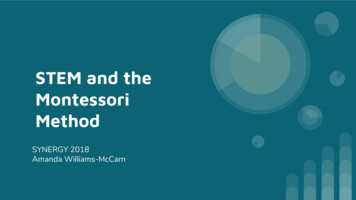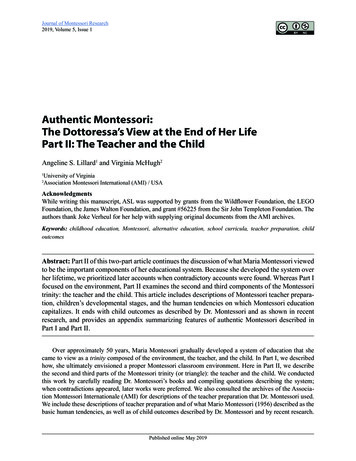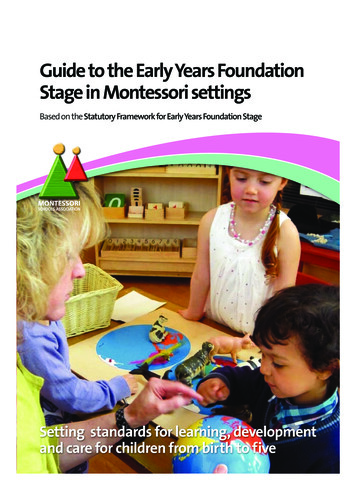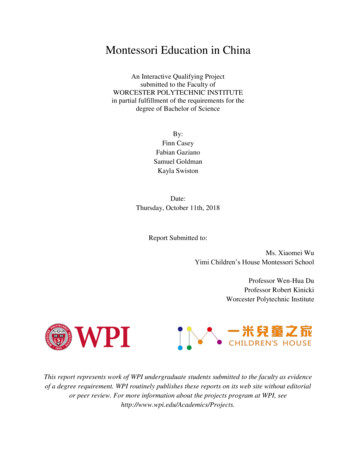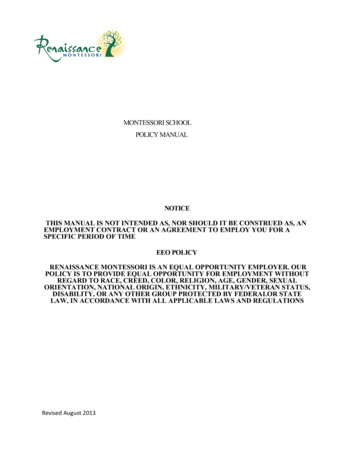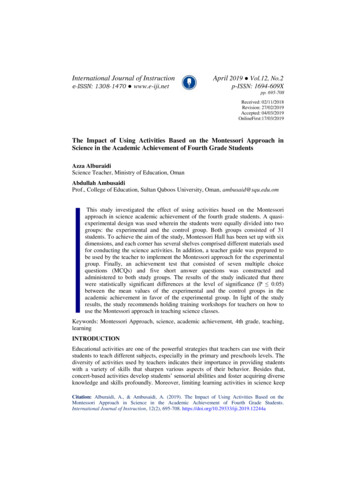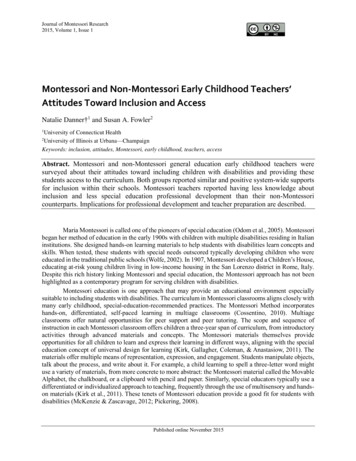
Transcription
Journal of Montessori Research2015, Volume 1, Issue 1Montessori and Non-Montessori Early Childhood Teachers’Attitudes Toward Inclusion and AccessNatalie Danner†1 and Susan A. Fowler21University of Connecticut HealthUniversity of Illinois at Urbana—ChampaignKeywords: inclusion, attitudes, Montessori, early childhood, teachers, access2Abstract. Montessori and non-Montessori general education early childhood teachers weresurveyed about their attitudes toward including children with disabilities and providing thesestudents access to the curriculum. Both groups reported similar and positive system-wide supportsfor inclusion within their schools. Montessori teachers reported having less knowledge aboutinclusion and less special education professional development than their non-Montessoricounterparts. Implications for professional development and teacher preparation are described.Maria Montessori is called one of the pioneers of special education (Odom et al., 2005). Montessoribegan her method of education in the early 1900s with children with multiple disabilities residing in Italianinstitutions. She designed hands-on learning materials to help students with disabilities learn concepts andskills. When tested, these students with special needs outscored typically developing children who wereeducated in the traditional public schools (Wolfe, 2002). In 1907, Montessori developed a Children’s House,educating at-risk young children living in low-income housing in the San Lorenzo district in Rome, Italy.Despite this rich history linking Montessori and special education, the Montessori approach has not beenhighlighted as a contemporary program for serving children with disabilities.Montessori education is one approach that may provide an educational environment especiallysuitable to including students with disabilities. The curriculum in Montessori classrooms aligns closely withmany early childhood, special-education-recommended practices. The Montessori Method incorporateshands-on, differentiated, self-paced learning in multiage classrooms (Cossentino, 2010). Multiageclassrooms offer natural opportunities for peer support and peer tutoring. The scope and sequence ofinstruction in each Montessori classroom offers children a three-year span of curriculum, from introductoryactivities through advanced materials and concepts. The Montessori materials themselves provideopportunities for all children to learn and express their learning in different ways, aligning with the specialeducation concept of universal design for learning (Kirk, Gallagher, Coleman, & Anastasiow, 2011). Thematerials offer multiple means of representation, expression, and engagement. Students manipulate objects,talk about the process, and write about it. For example, a child learning to spell a three-letter word mightuse a variety of materials, from more concrete to more abstract: the Montessori material called the MovableAlphabet, the chalkboard, or a clipboard with pencil and paper. Similarly, special educators typically use adifferentiated or individualized approach to teaching, frequently through the use of multisensory and handson materials (Kirk et al., 2011). These tenets of Montessori education provide a good fit for students withdisabilities (McKenzie & Zascavage, 2012; Pickering, 2008).Published online November 2015
TEACHERS’ ATTITUDES TOWARD INCLUSIONDanner and FowlerJoMR Fall 2015Volume 1 (1)The Montessori Approach in PracticeToday there are more than 4,000 Montessori schools in the United States, and more than 400 ofthese are public Montessori schools (American Montessori Society [AMS], 2015a). Although Montessorieducation is growing in public, charter, magnet, Head Start, and other quasipublic settings, this method ofeducation is most commonly found in private or independent schools in the U.S. In private settings,inclusion is not a legal requirement, according to the Individuals with Disabilities Education ImprovementAct of 2004 (IDEIA). Therefore, including students with disabilities in private or independent Montessorischools may not be a high priority for administrators. In addition, there is limited research on Montessoriand inclusion.In one of the few studies on Montessori inclusion, Montessori teachers reported that theircommitment to inclusion outweighed their reluctance and resistance to compromise their use of theMontessori Method (Epstein, 1997; 1998). Although teachers reported a fit between Montessori Methodsand inclusion, they also expressed frustration regarding children with challenging behavior in their classes.“If children’s needs required changes compromising Montessori Methods, [teachers] seriously questionedinclusion” (Epstein, 1997, p. 34). Within Montessori Early Childhood classrooms, gains in academic andsocial skills have been reported for both typically developing students (Lillard & Else-Quest, 2006) andchildren at risk for disabilities, as compared to other preschool programs (Miller, Dyer, Stevenson, & White,1975; Pickering, 1992). These positive results suggest that social and academic gains might bedemonstrated by students with disabilities attending Montessori schools as well.The Evolution of InclusionIn the field of early childhood special education, the definition for early childhood inclusion hasbeen evolving for several decades (Odom, Buysse, & Soukakou, 2011). A joint position statement on earlychildhood inclusion was created in 2009 through the collaboration of two major early childhoodorganizations, the Division for Early Childhood (DEC) and the National Association for the Education ofYoung Children (NAEYC). DEC/NAEYC (2009) made critical recommendations for early childhoodprograms, which include access to a wide range of learning opportunities and environments, participationthrough scaffolded learning, and provision of system-level supports as defining features of inclusion. Thisinclusion statement provides a framework for all schools, including Montessori schools, to apply withintheir program contexts.This study focuses on access, one part of the DEC/NAEYC definition of inclusion. Access provideschildren with disabilities the means to successfully enter a learning environment and successfully take partin the learning activities (DEC/NAEYC, 2009). Access was selected because of its pivotal role in providingopportunities for children to gain entry to school, the learning environment, and the curriculum. Withoutaccess, children cannot participate in events, learn, or receive supports. Access means removing physicalbarriers and offering multiple ways to promote learning and development to provide a wide range ofactivities and environments for every child. In the DEC/NAEYC inclusion statement, examples ofproviding access include features such as assistive technology, universal design for learning (UDL), andmodified learning activities for students. UDL is a concept that supports teaching through multiple methodsof presentation, engagement, and response. Through UDL, children have the opportunity to learn indifferent ways, e.g., auditory, visual, and kinesthetic, and can demonstrate acquisition of skills throughdifferent ways (Kirk et al., 2011).Research QuestionsThe purpose of this study was to compare Montessori and non-Montessori early childhood teacherattitudes toward inclusion. The study addressed two specific research questions: 1) What are early29
TEACHERS’ ATTITUDES TOWARD INCLUSIONDanner and FowlerJoMR Fall 2015Volume 1 (1)childhood teachers’ attitudes toward providing access for students with disabilities in their classrooms? and2) How are the attitudes of Montessori and non-Montessori early childhood teachers different or similar?MethodsAn online survey platform, SurveyMonkey, was used to survey two groups of teachers—Montessori and non-Montessori—in a large Midwestern state. The first group included AMS-credentialedteachers working in AMS-affiliated or AMS-accredited programs in Early Childhood classrooms. Thesecond group included early childhood state-certified, non-Montessori preschool teachers.Recruitment Procedures: MontessoriThe Montessori association for the large Midwestern state of interest emailed its member schoolsthrough its mailing list, which reaches over 100 Montessori schools, to invite participation. After receivingthe email, principals and directors of a number of member schools agreed to forward the survey link byemail to their early childhood teachers. Montessori events such as a local Montessori conference andannouncements at the target state’s Montessori organization’s monthly meetings, as well as through itssocial networking page served as resources to reach potential participants. Eighty-two Montessori teacherscompleted the survey. Response rate cannot be determined because there is no reliable list of the populationof credentialed Montessori Early Childhood teachers in this state.Recruitment Procedures: Non-MontessoriThe first author obtained the publicly available state-certified teacher list with a Freedom ofInformation Act request from the state’s board of education. This list contained the names and schooladdresses for a total of 1,153 teachers who were state certified in early childhood education. A data checkerused the information from this list to locate teachers’ school and work email addresses online. Of the 1,153early childhood teachers on the list, the data checker found 626 teachers with school email addresses. Aftersending an introductory email to those addresses, 503 email addresses were determined to be working andvalid, and not belonging to users who had opted out from online surveys. The survey link was directlyemailed from SurveyMonkey to these teachers to obtain their consent to participate in the study. Onehundred sixty-eight non-Montessori participants completed the survey, a response rate of 33.4% nonMontessori teachers.ParticipantsThe 250 eligible respondents were grouped as either Montessori (N 82) or non-Montessori (N 168) early childhood teachers. Teachers self-identified as Montessori teachers or not during the surveyprocess. Montessori teachers were slightly older, with a mean age of 46 (range: 27–68 years), than nonMontessori teachers, with a mean age of 42 (range: 25–63 years). Montessori and non-Montessori teachersindicated similar years of teaching experience, both having 13 years on average. As shown in Table 1,nearly all (99%) non-Montessori teachers and most (82%) Montessori teachers had experience teachingstudents with identified disabilities.30
TEACHERS’ ATTITUDES TOWARD INCLUSIONDanner and FowlerJoMR Fall 2015Volume 1 (1)Table 1Demographics of ParticipantsTeachersDemographicsHighest Education LevelDoctorateMaster’sBachelor’sType of SchoolPublicCharter / MagnetNot-for-ProfitFor-ProfitHead StartPrior Experience with Children withDisabilitiesYesNoFamily Member with a DisabilityYesNoYears Teaching Experience1–34–1011–1920 MontessoriN 82Percentage(n)Non-MontessoriN 5.9%36.0%30.7%27.5%(9)(55)(47)(42)The highest level of education varied significantly for Montessori and non-Montessori teachers.Most non-Montessori teachers (62%) held a master’s degree as their highest degree. In contrast, the highestdegree for most Montessori teachers (63%) was a bachelor’s degree. The type of school also differedsignificantly across the two groups of teachers. Nearly all non-Montessori (96%) teachers worked in publicschools. A majority of Montessori teachers (85%) worked in either nonprofit or for-profit private schools.InstrumentWe used an online survey design to contact a large number of teachers throughout the target statein a cost-effective way. The survey contained a total of 72 items developed by the first author. A skip-logicsurvey response path used participants’ prior responses to determine the sequence and number of subsequentquestions. The survey offered Likert-type scale items (n 49), multiple-choice items (n 17), and openended questions (n 6) about teachers’ perceptions and practices of inclusion. Based on time tests, thesurvey took an average of 20 minutes to complete. All institutional review board (IRB) requirements werefollowed.Survey items measured (a) teachers’ thoughts about inclusion, which included the ideas and beliefsthey had about including students with disabilities in typical classrooms; (b) teachers’ positive, negative, orneutral feelings about inclusion; and (c) teachers’ behavior in inclusive classrooms, which focused on theirteaching practices and instructional styles (Triandis, 1971).Cognitive interviews, expert reviews, and a time test served to attest to the validity of the surveyitems. Montessori (n 3) and non-Montessori (n 15) practicing and preservice teachers completedcognitive interviews. One Montessori head of school and one Montessori teacher educator served as expertreviewers of the survey instrument. To improve clarity and ease of use, we revised the instrument based on31
TEACHERS’ ATTITUDES TOWARD INCLUSIONDanner and FowlerJoMR Fall 2015Volume 1 (1)feedback from each phase of cognitive interviews and expert reviews. Two graduate students in specialeducation completed time tests.Data AnalysisSurvey items measuring attitudes, feelings, knowledge, and behaviors about inclusion weresubjected to principal component analysis (PCA) using SPSS version 21. Before performing PCA, weassessed the suitability of data for factor analysis. Initial inspection of the correlation matrix revealed thepresence of many coefficients below 0.2. We decided to remove from the matrix survey items focused onthe use of assistive technology, as they seemed to be outliers that measured another construct. Once theseitems were removed and the correlation matrix was run on the remaining survey items (n 23), we sawmany coefficients of 0.3 and above. The Kaiser–Meyer–Olkin value was .688, exceeding the recommendedvalue of .6 (Kaiser, 1970; 1974). Bartlett’s test of sphericity (Bartlett, 1954) reached statistical significance(0.00), supporting the factorability of the correlation matrix.Principal component analysis revealed the presence of nine components with eigenvaluesexceeding 1, explaining 17.5%, 11.5%, 7.5%, 6.6%, 6.3%, 5.7%, 4.8%, 4.7%, and 4.4% of the variancerespectively. An inspection of the scree plot revealed a clear break after the third component. Using Cattell’sscree test (1966), we decided to retain three components for further investigation.The three-component solution explained a total of 36.5% of the variance, with Component 1contributing 17.5%, Component 2 contributing 11.5%, and Component 3 contributing 7.5%. To aid in theinterpretation of these three components, oblimin rotation was performed. The rotated solution revealed thepresence of simple structure (Thurstone, 1947); all three components showed a number of strong loadings,and all variables loaded substantially on only one component. There was a weak negative correlationbetween Components 1 and 2 (r –.05) and a weak positive correlation between Components 1 and 3 (r .11) and Components 2 and 3 (r .05). The results of this analysis clearly grouped survey items measuringknowledge and behaviors about inclusion (n 7) in Component 1, supports for inclusion (n 5) inComponent 2, and feelings about inclusion (n 8) in Component 3.32
JoMR Fall 2015Volume 1 (1)TEACHERS’ ATTITUDES TOWARD INCLUSIONDanner and FowlerTable 2Pattern and Structure Matrix for PCA with Oblimin Rotation of Three-Factor Solution of Survey ItemsPattern coefficientsStructure coefficientsItemComponent Component ComponentComponent Component . Major loadings for each item are in 9.280.380.199.273.273.183
TEACHERS’ ATTITUDES TOWARD INCLUSIONDanner and FowlerJoMR Fall 2015Volume 1 (1)ResultsNumber of Students with Disabilities and Disability TypeDescriptive statistics were used to show differences between Montessori and non-Montessoriteachers’ current number of students with disabilities. As shown in Table 3, Montessori teachers, on average,served two children with IEPs or identified disabilities in their classrooms, while non-Montessori teachersserved on average eight. Almost half (49.3%) of Montessori teachers had no children with disabilities intheir current classrooms.Table 3Number of Students with Disabilities Included in ClassroomsHow many students in yourcurrent classroom have anMontessoriIEP or identified disability?N –93.0%(2)10 1.5%(1)Mean (SD)2.2 (1.8)TeachersNon-MontessoriN 49)(53)7.8 (3.1)In general, non-Montessorians indicated a greater variety of disabilities represented in theirclassrooms than did teachers in Montessori classrooms. Montessori teachers on average indicated one ortwo types of disabilities represented in their classrooms, while non-Montessori teachers indicated onaverage four or five disability types. Non-Montessori teachers were much more likely to teach childrenidentified as having a developmental delay (68%), speech or language impairment (82%), or other healthimpairment (20%) as compared to Montessori teachers (33%, 45%, and 0% respectively). The vast majorityof non-Montessori teachers (82%) indicated working with a child with a speech or language impairment intheir classrooms; speech and language impairments are the most frequently selected disability type for bothgroups of teachers. Neither group reported working with children who are deaf-blind. Few teachers acrossboth groups served children with intellectual disabilities, traumatic brain injuries, or visual impairments.34
TEACHERS’ ATTITUDES TOWARD INCLUSIONDanner and FowlerJoMR Fall 2015Volume 1 (1)Table 4Types of Disabilities Represented in ClassroomsClassroomsOf the students with IEPsand identified disabilitiesin your current classroom,what type(s) of disabilitiesare represented?Autism spectrum disordersDeafness or hearingimpairmentDeaf-blindnessDevelopmental delayEmotional disturbanceIntellectual disabilityLearning disabilityMultiple disabilitiesOrthopedic impairmentOther health impairmentSpeech or languageimpairmentTraumatic brain injuryVisual impairment,including blindnessMontessoriN 4928.6%(n)(14)Non-MontessoriN (9)Total number ofdisabilities checked151.0%(74)272.7%(450)Note. Respondents indicated all disabilities that apply in their classroom; therefore, the totals are more than 100%.Regarding Table 4, it is important to note that numerous Montessori teachers (n 33) and severalnon-Montessori teachers (n 3) were ineligible to respond to this item because they had indicated earlierin the survey an absence of students with identified disabilities in their current classrooms. This resultsignificantly reduced the number of Montessori teacher responses to this item.ComponentsSurvey results were analyzed between Montessori and non-Montessori teachers using survey itemsgrouped by each of the three principal components.Component 1: Knowledge of InclusionA one-way, between-groups, multivariate analysis of variance was performed to investigateteacher-type (Montessori or non-Montessori) differences in knowledge of inclusion. Six dependentvariables were used: how often teachers modify learning activities, how often they use universal design forlearning, how often they use assistive technology, how much they know about universal design for learning,how much they know about modifying learning activities, and how much they know about assistivetechnology. The independent variable was teacher type. There was a statistically significant differencebetween Montessori and non-Montessori teachers on the combined dependent variables: F(6, 220) 7.84,p .000; Wilks’s lambda .824; partial eta squared .176. When the results for the dependent variableswere considered separately, all differences reached statistically significant values, using a Bonferroniadjusted alpha level of .008, except how often universal design for learning was used. An inspection of the35
TEACHERS’ ATTITUDES TOWARD INCLUSIONDanner and FowlerJoMR Fall 2015Volume 1 (1)mean scores indicated that non-Montessori teachers reported higher levels of both inclusion knowledge andinclusion practice than did Montessori teachers.Component 2: Supports for InclusionA one-way, between-groups, multivariate analysis of variance was performed to investigateteacher-type (Montessori or non-Montessori) differences in supports for inclusion. Five dependent variableswere used: how important these types of supports are for students with identified disabilities, one-on-oneadult support, support services, support from school administrators, collaborating within the classroomteam, and support from families. The independent variable was teacher type. There was a statisticallysignificant difference between Montessori and non-Montessori teachers on the five combined dependentvariables: F(5, 220) 3.74, p .003; Wilks’s lambda .922; partial eta squared .078. However, when theresults for the dependent variables were considered separately, the only difference that reached statisticalsignificance, using a Bonferroni-adjusted alpha level of .01, was support services. An inspection of themean scores indicated that non-Montessori teachers value support services such as physical therapy,occupational therapy, and speech language pathology at a slightly higher level than do Montessori teachers.Both Montessori and non-Montessori teachers value at a similar, high level other supports such as one-onone adult support, support from school administrators, collaborating within the classroom team, and supportfrom familiesComponent 3: Feelings about InclusionA one-way, between-groups, multivariate analysis of variance was performed to investigateteacher-type (Montessori or non-Montessori) differences in feelings about inclusion. Eight dependentvariables addressed teachers’ feelings about student belonging (one variable), modification of materials(two variables), adapting the classroom environment (four variables), and assistive technology (onevariable). The independent variable was teacher type. There was a statistically significant differencebetween Montessori and non-Montessori teachers on the combined dependent variables, F(8, 206) 3.88,p .000; Wilks’s lambda .869; partial eta squared .131. When the results for the dependent variableswere considered separately, no differences reached statistical significance, using a Bonferroni-adjustedalpha level of .006. Therefore, Montessori and non-Montessori teachers indicated similar feelings aboutstudent belonging, modifications of materials, adapting the classroom environment, and assistivetechnology.Correlation Between Special Education Coursework and Knowledge of InclusionThe relationship between completed special education coursework and knowledge of inclusion(Component 1, consisting of six survey items) was investigated using Pearson product-moment correlationcoefficient. There was a strong, negative correlation between special education coursework and teacherreported frequency of use of assistive technology in the classroom, r –.317, n 219, p .001; extensivespecial education coursework was associated with lower use of assistive technology. There was a strong,positive correlation between special education coursework and how knowledgeable the teachers ratedthemselves on modifying learning activities, r .211, n 217, p .001; greater special educationcoursework was associated with greater knowledge of modifying learning activities. There was a strong,positive correlation between special education coursework and how knowledgeable teachers ratedthemselves on the topic of assistive technology, r .278, n 208, p .001, with higher levels of specialeducation coursework associated with greater knowledge about assistive technology.36
TEACHERS’ ATTITUDES TOWARD INCLUSIONDanner and FowlerJoMR Fall 2015Volume 1 (1)Table 5Pearson Correlations Between Special Education Coursework and Knowledge of InclusionSurvey Items inComponent 1: Knowledge of InclusionSpecial Education CourseworkHow often teachers modify learning activities–.095How often teachers use universal design for learning–.080How often teachers use assistive technology–.317**How much teachers know about universal design for learning–.121How much teachers know about modifying learning activities.211**How much teachers know about assistive technology** p .01 (two-tailed).278**DiscussionThis is the first known study on inclusion that directly compares early childhood teachers withMontessori credentials to teachers with other credentials. Results are consistent with studies on theMontessori-only population (Epstein, 1997; 1998), in which Montessori teachers indicated positiveattitudes toward including students with special needs in their classrooms.Similarities Between Montessori and Non-Montessori TeachersTeacher responses were similar on many items within the survey. Interestingly, even thoughMontessori and non-Montessori teachers in this study worked in different types of schools (private andpublic), they both indicated that they valued similar, positive supports for inclusion within their schools. Inpublic schools, legal requirements usually compel administrators to be well prepared for the inclusion ofstudents with disabilities (with curricula, interventions, specialists, etc.) (IDEIA, 2004). Legally, private orindependent schools must make reasonable accommodations for students with disabilities, but they are notrequired to include children whose needs would place an undue burden on the school. Even so, theMontessori teachers at private schools in this study expressed strong support for inclusion and respondedsimilarly to non-Montessori teachers in public schools. This indication could show that private Montessorischools are welcoming and responsive to students with disabilities, consistent with recent survey resultsabout students with disabilities in Montessori schools (Kahn, 2009).Surprisingly, both groups also indicated similar positive feelings about inclusion. Both Montessoriand non-Montessori teachers agreed with many statements about promoting all students’ belonging,modifying classroom materials, adapting the environment to meet the needs of students in their classes, andusing assistive technology for students with disabilities. Even though Montessori teachers in this study hadless experience teaching children with disabilities, their feelings about inclusion remained positive.Montessori teachers’ positive feelings about inclusion align with the observation that Montessori practicesand materials are well suited for children to learn at their own rate, allow for repetition, and are congruentwith many special education practices such as UDL (Cossentino, 2010).In this study, we had originally intended to compare four groups: Montessori teachers with andwithout experience teaching students with disabilities and non-Montessori teachers with and withoutexperience teaching students with disabilities. However, due to respondents’ high responses indicating theirexperience teaching students with disabilities (82.3% for Montessori teachers and 98.8% for nonMontessori teachers), this comparison was not feasible. This finding was unexpected and may reflect theincreasing placement of young children with disabilities into inclusive general education preschool37
TEACHERS’ ATTITUDES TOWARD INCLUSIONDanner and FowlerJoMR Fall 2015Volume 1 (1)classrooms (Odom et al., 2011). Additionally, professionals with experience teaching students withdisabilities may have been more inclined to participate in this survey, skewing the participant pool.Differences Between Montessori and Non-Montessori TeachersOne important difference between the Montessori and non-Montessori groups was in the“knowledge about inclusion” component. Montessori teachers rated themselves significantly lessknowledgeable about inclusion than did non-Montessori teachers. This finding could be due to the lattergroup’s prior special education coursework and enrollment in teacher preparation programs. NonMontessori teachers, on average, had completed more than three college courses in special education,whereas most Montessori teachers indicated they had had no special education college coursework butrather had attended workshops or seminars on the topic. Non-Montessori teachers often attend bachelor’slevel teacher-preparation programs in universities or colleges, where the completion of several specialeducation courses may be required. Additionally, a majority of non-Montessori participants held master’sdegrees, which likely increased their opportunities to take additional coursework in special education.In contrast, to become Montessori credentialed, teachers need a bachelor’s degree in any field andthen must attend a stand-alone, Montessori teacher-preparation program. Therefore, their undergraduatestudies and Montessori training may or may not have included content in special education. Because oftheir more varied college educations, Montessori teachers may not recognize how closely the Montessoriapproach aligns with special-educatio
Most non-Montessori teachers (62%) held a master's degree as their highest degree. In contrast, the highest degree for most Montessori teachers (63%) was a bachelor's degree. The type of school also differed significantly across the two groups of teachers. Nearly all non-Montessori (96%) teachers worked in public schools.
